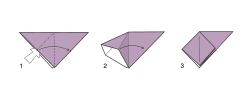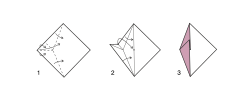Yoshizawa Randlett System
The Yoshizawa Randlett system is a unified notation system for the graphical representation of folding steps in origami models . These standardized diagrams can be found in almost all origami books sold worldwide today, which also means that the models are divided into different levels of difficulty.
Emergence
Early origami books used a wide variety of systems to illustrate folding processes, whether by drawing or photography. The earliest origami instructions can be found in the Senbazuru Orikata , published in 1797 , freely translated as 1000 origami cranes, which shows different variants of folding several connected origami cranes. It does not contain step-by-step instructions, just the folding pattern for the crane and diagrams on how to cut the paper.
In 1954, Akira Yoshizawa published a monograph entitled Atarashi Origami Geijutsu (New Art of Origami), in which he proposed a system that used dashed and dotted lines to represent valley folds and a few other symbols. This system caught the attention of Samuel Randlett and Robert Harbin , who expanded it to include additional symbols and thus developed it into a standard. The Yoshizawa Randlett system was first published in Samuel Randlett's Art of Origami in 1961 . The system was quickly adopted by the international origami community and is still in use today.
Origami symbols
Base folds
Two types of origami symbols are used: arrows, which show how the paper is moved and which direction to fold, and lines, which are distinguished as follows:
- Thick lines show corners and edges.
- Thin lines that do not touch the edges of the paper indicate an already folded fold.
- Dashed lines show valley folds.
- A dash-dotted line indicates a mountain fold.
- A dotted line shows an invisible corner or edge or the goal of the folding step.
Extended folds
The following folds usually require several manipulations:
Compound folds
Compound folds are difficult to represent with simple diagrams, so that they are often represented with (spatially visualized) intermediate steps. The most important, often recurring compound folds are:
Individual evidence
- ↑ Nick Robinson: The Origami Bible . Chrysalis Books, 2004, ISBN 1-84340-105-3 , pp. 18 (English).
- ↑ Peter Engel: Origami from Anglefish to Zen . Dover, 1989, ISBN 0-486-28138-8 , pp. 8 (English).























